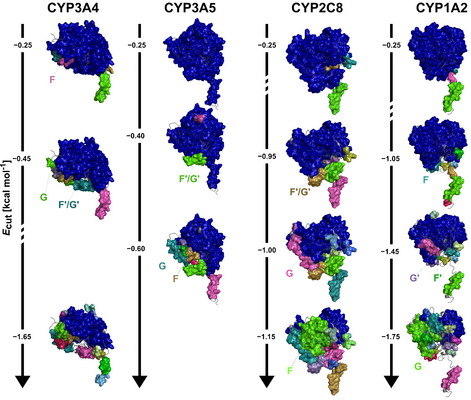LIFE SCIENCES
Reactive Metabolites from Drugs: Generation and Impact Prediction by Computational Biophysical Chemistry
Principal Investigator:
Prof. Holger Gohlke
Affiliation:
Institute for Pharmaceutical and Medicinal Chemistry, Heinrich Heine University Düsseldorf, Germany
Local Project ID:
CYP450
HPC Platform used:
JEWELS BOOSTER at JSC
Date published:

Figure 1: Constraint network analysis of CYP3A4, CYP3A5, CYP2C8, and CYP1A2 and rigid cluster decompositions along constraint dilution trajectories. Rigid clusters of the CYP isoforms at different Ecut values are colored blue, green, pink, and cyan in descending order of their size. The examples qualitatively depict that the F/G-region of more promiscuous CYP isoforms, such as CYP3A4 and CYP3A5, are less structurally stable than that of more specific isoforms. Furthermore, differences in structural stability are revealed for sequentially close isoforms. The rigid clusters are calculated based on the neighbor stability map of one exemplary MD trajectory, respectively. Figure taken from ref. J. Chem. Inf. Model. 2021, 61, 4023–4030.
A research team led by Prof. Dr. Holger Gohlke at the Heinrich Heine University of Düsseldorf is a long-time user of the Jülich Supercomputing Centre’s (JSC’s) world-class high-performance computing infrastructure. The team has recently employed JSC’s JUWELS supercomputer to study a select class of enyzmes that play an outsized role in metabolizing chemical compounds coming from outside the body. Specifically, it has been focused on 12 cytochrome P450 (CYP) enzymes and the relationship between their substrate promiscuity and the flexibility of the substrate entrance tunnels. In its simulations, the team ultimately found an inverse relationship between the molecular structure’s rigidity of this region and enzymes’ substrate scope. These results set the course for further investigation and offer promise for advanced biotechnological applications.
The team published its results in the Journal of Chemical Information and Modeling.
For the full report, click here.
For the publication, click here